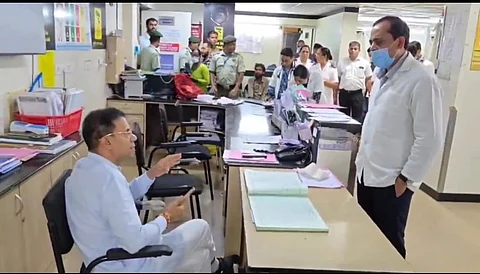

The video that was meant to showcase minister defending the patients, instead became a flashpoint exposing fault lines in India's healthcare system.
On June 7, 2025, Goa Health Minister Vishwajit Rane stormed into Goa Medical College Hospital's (GMC) casualty ward with cameras rolling, publicly berating and suspending Dr Rudresh Kuttikar for allegedly denying an injection to a patient.
The reality was starkly different. Dr Kuttikar had followed protocol, directing a stable patient to receive a non-emergency Vitamin B12 injection at an appropriate Urban Health Centre rather than in an overcrowded emergency ward.
Within 24 hours, Chief Minister Pramod Sawant overruled the suspension, but the damage was done.
“Doctors have increasingly become soft targets for political grandstanding,” says Dr Dhruv Chauhan, National Spokesperson for the Indian Medical Association (IMA). “Time and again, we've seen politicians believe that by publicly targeting doctors, often under the pretense of showing concern for patients, they can gain public sympathy and political mileage. This has become a calculated strategy, not an isolated incident.”
The strategy works by exploiting public frustration with India’s overburdened healthcare system. By scapegoating individual doctors rather than addressing systemic underfunding, politicians deflect from their own policy failures while appearing to champion the common man.
Dr Suvrankar Datta from All India Institute of Medical Sciences (AIIMS) places the incident within a broader VIP culture that has transformed public hospitals into “private extensions of political power.” Recalling his residency, he notes how politicians often demanded preferential treatment regardless of clinical urgency.
“We are trained to treat patients based on need, not status,” he emphasises. “No politician’s associate deserves emergency attention over a critically ill poor patient simply because of their connections.”
The aftermath illustrated how political theatrics cascade into violence. Emboldened by the minister’s assault on medical authority, miscreants reportedly entered the same hospital and threatened doctors. This progression from political interference to mob intimidation reflects systematic undermining of institutional respect that healthcare requires.
The medical community’s response was swift and unified. The Goa Association of Resident Doctors (GARD) issued a 48-hour ultimatum threatening strike action if public apology, protection and assurances were not provided. Several other local medical bodies joined in solidarity, staging peaceful protests demanding safeguards from political meddling, respect for due process, and legal protection for healthcare workers.
The incident also violated constitutional safeguard. Article 311 prohibits suspension by authorities subordinate to the appointing authority. Dr Kuttikar’s public suspension without formal charges or hearings was legally void, requiring Chief Ministerial intervention to correct the breach.
The psychological toll of such incidents on young doctors is devastating. Dr Datta identifies two trends: doctors abandoning clinical practice and massive talent outflow abroad. “Applications for USMLE (United States Medical Licensing Examination) and PLAB (Professional and Linguistic Assessments Board) are soaring,” he explains. “These countries offer not just better pay, but dignity, safety, and respect. You cannot barge into an emergency room there. You cannot threaten or film a doctor without consequence.”
This brain drain hemorrhages human capital India desperately needs. India spends barely 2% of its GDP on healthcare, far below the WHO recommended minimum of 5%. This chronic underfunding creates the overcrowded, understaffed conditions that fuel both patient frustration and political opportunism.
When two doctors are expected to do the work of six, when residents work 36-hour shifts, when basic equipment is lacking, the system becomes a pressure cooker waiting to explode.
While legal frameworks exist to protect healthcare workers, such as Bharatiya Nyaya Sanhita (BNS) provisions against obstructing public servants, but enforcement remains absent. “Laws without implementation are as good as no laws,” Dr Chauhan observes. “When doctors are assaulted or harassed, what follows is silence or tokenism, not action.”
The medical community demands Central Protection Act for healthcare professionals, but governments resist, citing precedent concerns for other professions. This misses doctors' unique vulnerabilities, working amid high emotion, life-and-death decisions, and administrative pressure where tensions quickly escalate.
The irony is stark. During COVID-19, these same vilified doctors were hailed as frontline heroes, working without adequate protection. The contrast reveals how quickly sentiment shifts and how easily politicians exploit it.
Individual apologies and symbolic gestures cannot address such systemic failures. Hospitals should be designated as protected zones or safe zones, similar to airports or courts, with regulated access and severe consequences for disruption. “No one should storm into an emergency ward with cameras and entourages, turning healing spaces into political theater,” Dr Datta argues.
This is especially urgent in light of recent incidents at Guru Teg Bahadur Hospital (GTB) and University College of Medical Sciences (UCMS) hospital in Delhi, where violent altercations endangered healthcare workers.
The Goa incident is not an anomaly but a symptom of deeper dysfunctions in how India treats its healthcare system and professionals.
India faces a stark choice: reform the system to support healthcare workers, or watch helplessly as they leave for places that will. A society's treatment of its doctors reveals its values and priorities. The time for band-aid solutions has passed; what's needed now is surgery on the system itself.
